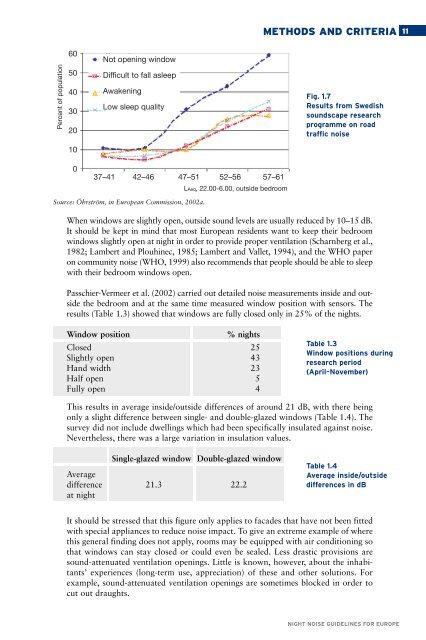Night noise guidelines for Europe - WHO/Europe - World Health ...
Night noise guidelines for Europe - WHO/Europe - World Health ...
Night noise guidelines for Europe - WHO/Europe - World Health ...
Create successful ePaper yourself
Turn your PDF publications into a flip-book with our unique Google optimized e-Paper software.
METHODS AND CRITERIA 11<br />
60<br />
Not opening window<br />
Percent of population<br />
50<br />
40<br />
30<br />
20<br />
Difficult to fall asleep<br />
Awakening<br />
Low sleep quality<br />
Fig. 1.7<br />
Results from Swedish<br />
soundscape research<br />
programme on road<br />
traffic <strong>noise</strong><br />
10<br />
0<br />
37–41 42–46 47–51 52–56 57–61<br />
LAeq, 22.00-6.00, outside bedroom<br />
Source: Öhrström, in <strong>Europe</strong>an Commission, 2002a.<br />
When windows are slightly open, outside sound levels are usually reduced by 10–15 dB.<br />
It should be kept in mind that most <strong>Europe</strong>an residents want to keep their bedroom<br />
windows slightly open at night in order to provide proper ventilation (Scharnberg et al.,<br />
1982; Lambert and Plouhinec, 1985; Lambert and Vallet, 1994), and the <strong>WHO</strong> paper<br />
on community <strong>noise</strong> (<strong>WHO</strong>, 1999) also recommends that people should be able to sleep<br />
with their bedroom windows open.<br />
Passchier-Vermeer et al. (2002) carried out detailed <strong>noise</strong> measurements inside and outside<br />
the bedroom and at the same time measured window position with sensors. The<br />
results (Table 1.3) showed that windows are fully closed only in 25% of the nights.<br />
Window position<br />
% nights<br />
Closed 25<br />
Slightly open 43<br />
Hand width 23<br />
Half open 5<br />
Fully open 4<br />
Table 1.3<br />
Window positions during<br />
research period<br />
(April–November)<br />
This results in average inside/outside differences of around 21 dB, with there being<br />
only a slight difference between single- and double-glazed windows (Table 1.4). The<br />
survey did not include dwellings which had been specifically insulated against <strong>noise</strong>.<br />
Nevertheless, there was a large variation in insulation values.<br />
Single-glazed window Double-glazed window<br />
Average<br />
difference 21.3 22.2<br />
at night<br />
Table 1.4<br />
Average inside/outside<br />
differences in dB<br />
It should be stressed that this figure only applies to facades that have not been fitted<br />
with special appliances to reduce <strong>noise</strong> impact. To give an extreme example of where<br />
this general finding does not apply, rooms may be equipped with air conditioning so<br />
that windows can stay closed or could even be sealed. Less drastic provisions are<br />
sound-attenuated ventilation openings. Little is known, however, about the inhabitants’<br />
experiences (long-term use, appreciation) of these and other solutions. For<br />
example, sound-attenuated ventilation openings are sometimes blocked in order to<br />
cut out draughts.<br />
NIGHT NOISE GUIDELINES FOR EUROPE

















